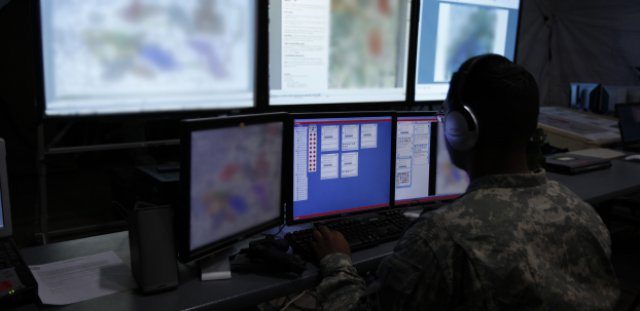A new military occupational specialty: Cryptologic Network Warfare Specialist (35Q) opened last month.
“About 500 to 600 Soldiers are needed initially,” said Lt. Col. Kurt Connell, Military Intelligence Enlisted Branch chief, “but as we fully develop the career path, we’ll probably identify additional authorizations, none of which involve force structure changes.”
Soldiers from any MOS may apply as long as their current MOS will release them to reclassify into this new field, he said, adding that for now, Soldiers in the grades of E-3 to E-6, serving in the active force are eligible.
“A 35 Quebec supervises and conducts full-spectrum military cryptologic digital operations to enable actions in all domains, NIPRNet as well as SIPRNet, to ensure friendly freedom of action in cyberspace and deny adversaries the same,” said Sgt. 1st Class Dan Gutierrez, 35Q CNW senior enlisted advisor.
The NIPRNet is the unclassified but sensitive portion of the Defense Department’s Internet network and the SIPRNet is the secret portion. Gutierrez was not authorized to elaborate on actions taken to “deny adversaries,” due to the classified nature of the work, but he said that when appropriate, a 35Q would “take the fight to our adversaries” to deny them the cyberspace privileges that pose threats to national security.
Although the MOS is new, Soldiers have been doing that intelligence work while in related intelligence MOSs for a number of years in various locations.
“We identified those Soldiers who were doing this type of work for a significant amount of time,” Gutierrez said. The MOS was created to “keep them in this field so their skills don’t atrophy over time.
“If you have a 35N (Signals Intelligence Analyst), for example, a traditional signals analyst doing what Quebecs are doing now, there was no way to track them and ensure their skills remained relevant as times change in field,” he continued. “If a 35N went on to another assignment (outside of what a 35Q now does), we could lose those highly perishable skills. So the new MOS was created to ensure those Soldiers stay proficient and on top of their game.”
Gutierrez said recruiters already identified candidates for 35Q back in June and they started school in October at the 24-week Joint Cyber Analysis Course in Pensacola, Fla.
“About 80 percent of new 35Qs are new accessions coming off the street and 20 percent are from reclassifying Soldiers,” Connell said, adding that moves into the MOS are voluntary.
Connell thinks there will be no problem continuing to get and retain 35Q volunteers because it’s a “highly sought after skill set and a highly sought after field so we don’t anticipate shortfalls.”
He emphasized the importance of interested Soldiers talking to their career counselors right away to determine if they qualify and then take the necessary steps to initiate the process.
One requirement is that a score of 109 is needed on the Armed Services Vocational Aptitude Battery for those who took the test prior to Jan. 2, 2002, and 105 or better after that date. Also, the two pertinent documents on the new MOS can be found in Military Personnel messages 12-173 and 12-187.










